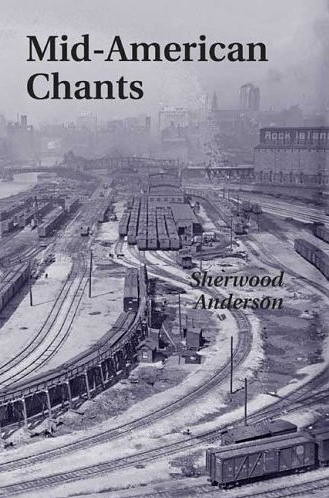Writing of Gabe Gudding’s essay on the impact of creative writing programs on the evolution of American poetry yesterday, I noted that at “its heart, what [Gudding’s essay] asks us to do is to think what the poem might be absent this particular literary history.” I found myself thinking of that exact question while reading the latest book from Quale Press, Sherwood Anderson’s Mid-American Chants. Originally published in 1918, Mid-American Chants is an anomaly, a relatively early work – his third book – of a late starter (Anderson was 42 when it first came out, four years after his first novel, Windy McPherson’s Son), a collection of poetry from an author known for his fiction. Here is a reasonably typical example, entitled “Song to New Song”:
Over my city Chicago a singer arises to sing.
I greet thee, hoarse and terrible singer, half man, half bird, strong, winged one.
I see you float in cold bleak winds,
Your wings burned by the fires of furnaces,
In all your cries so little that is beautiful,
Only the fact that you have risen out of the din and roar to float and wait and point the way to song.
Back of your grim city, singer, the long flat fields.
Corn that stands up in orderly rows, full of purpose.
As you float and wait, uttering your hoarse cries
I see new beauties in the standing corn,
And dream of singers yet to come,
When you and your rude kind, choked by the fury of your furnaces,
Have fallen dead upon this coal heap here.
Kneeling in prayer I shall forget you not, grim singer,
Black bird, black against your black smoke-laden sky,
Uttering your hoarse and terrible cries,
The while you do strive to catch and understand
The faint and long forgotten quality of song,
By never sweeter singers to be sung.
Several things in this text stand out, above & beyond the obvious influence of Whitman. One is the fact that there is nothing personal here about the use of the first person singular. Is “I” here even a person? More accurately, it strikes me as a rhetorical position. Nor is there anything personal, even personified, about “you,” bird man of the furnaces. Rather, this is a kind of public, figurative language we hardly hear any more, save possibly in church. If it seems preposterous or stilted or dated, that is the index of just how far outside our expectations such language is today within the poem.
And yet it is not, clearly, a sign of any weakness on the author’s part – rhythmically, this work is rock solid. You can tell almost instantly just how certain of his craft
It’s hard for me to imagine that this kind of poetry was possible less than 30 years before I was born – my ear hears it as tho an echo of another age altogether. But of course those 30 years were not just the period of the rise of the creative writing program with its emphasis on getting in touch with personal experience, but also of aural mass communication for the very first time as radio, in particular, and later motion pictures made the spoken word something that could take place on a one-to-many basis for the very first time. The very first thing you noticed about an emerging public figure like JFK or Lyndon Johnson was that they “talked funny,” which is to say that each showed pronounced vestiges of a regional accent. A lot of that has dissolved for those of us who grew up in the years immediately after World War 2, especially after corporations began to dictate the movement of families hither and yon over the landscape. So
One of the listservs I’m on has had a somewhat similar discussion about a more recent project, Robert Duncan’s Ground Work, recently reissued by New Directions. Some writers there noted that they had not gotten into his work because they found it grim. I hardly think of it myself in those terms, but I do think that it insists on the seriousness of poetry itself as a vocation, and that Duncan himself – even where he farms his childhood and family mysteries for material – never particularly saw the poem as an occasion for personal expression. He was, literally, much more interested in the transpersonal, the idea that, as he put in an earlier poem, the dance exists prior to the presence of any dancers, who are merely “permitted to return” from time to time. It’s a view as old as Blake’s, but one that is a far cry from the experiential voice of the old McPoem of creative writing workshops and from the phenomenological sweep, say, one finds in much language (and post-) poetry.
Once you begin to do this, you start to see other kinds of poetry that likewise fall outside of Gudding’s model – the whole of vispo for one – and you begin to wonder what it means that this alternate tradition has not, at least to this point, ever been articulated as such. Is it that they have not had the institutional advantage of the MFA programs that carry forward the “growth agenda” of creative writing. Where, say, does Kenny Goldsmith’s “uncreative writing” fit into such a counter tradition? Or the post-dada noodling of the likes of Fluxus or Dick Higgins? Or, for that matter, Gertrude Stein.
I don’t – today, anyway – have answers. But looking at the world through Gudding’s glasses does tend to bring different elements into focus. And that’s what I find interesting.






